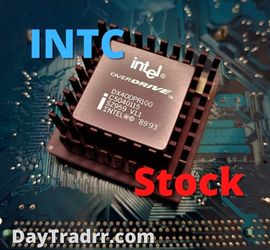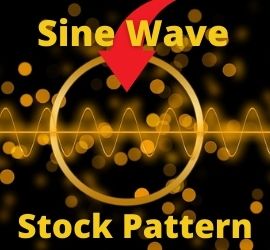INTC Stock – What Investors Should Know About Intel Corp.
 Intel Corporation (INTC Stock Ticker) creates, manufactures, and sells computer products and technologies. Intel is best known for creating microprocessors that power the majority of the world’s personal computers. The multinational technology company is also the world’s largest manufacturer of semiconductor chips in terms of revenue. These are essential building blocks used in the majority of the world’s electronic devices. Intel microprocessors are supplied to and used in computers by a number of large technology companies. For example, Dell, HP, and Lenovo.
Intel Corporation (INTC Stock Ticker) creates, manufactures, and sells computer products and technologies. Intel is best known for creating microprocessors that power the majority of the world’s personal computers. The multinational technology company is also the world’s largest manufacturer of semiconductor chips in terms of revenue. These are essential building blocks used in the majority of the world’s electronic devices. Intel microprocessors are supplied to and used in computers by a number of large technology companies. For example, Dell, HP, and Lenovo.
Graphics chips, flash memory, motherboard chipsets, and other computing devices are also produced by Intel. The chipmaker has made significant investments in the field of artificial intelligence in recent years. It provides platforms for computers, networking, data storage, and communications. The firm operates through the following segments: Client Computing Group (CCG), Data Center Group (DCG), Internet of Things Group (IOTG), Non-Volatile Memory Solutions Group (NSG), Programmable Solutions (PSG), and All Other. The CCG segment consists of platforms designed for notebooks, 2-in-1 systems, desktops, tablets, phones, wireless and wired connectivity products, and mobile communication components.
More About Intel Inc.
Intel Corp. creates and sells computer components and peripherals. It creates computing and communication components such as microprocessors, chipsets, motherboards, and wireless and wired connectivity. The firm creates advanced integrated digital technology products, primarily integrated circuits, for industries like computing and communications. It also creates platforms, which are defined as “integrated suites of digital computing technologies designed and configured to work together to provide an optimized user computing solution.” On July 18, 1968, Robert Norton Noyce and Gordon Earle Moore founded the company. Intel is headquartered in Santa Clara, California with regional offices around the globe.
Intel Corporation products and technologies.
- DCG segment includes workload-optimized platforms and related products. They are designed for the enterprise, cloud, and communication infrastructure markets. Products provide computing, storage, and network functions.
- CCG segment is focused on the long-term operating systems, system architecture, hardware, and application integration that enable PC experiences.
- IOTG segment offers computing solutions for targeted verticals and embedded applications for the retail, manufacturing, health care, energy, automotive, and government market segments. It develops high-performance computing platforms that solve the technology needs for business use cases. Applications scale across vertical industries and embedded markets.
- NSG segment is composed of NAND flash memory products primarily used in solid-state drives. These memory and storage products are based on Intel 3D NAND technology.
- PSG segment contains programmable semiconductors and related products for a broad range of markets, including communications, data centers, industrial, military, and automotive. The PSG segment offers programmable FPGAs, structured ASICs, and related products.
- All Other segment consists of results from other non-reportable segments and corporate-related charges.
INTC Stock SEC Filings – Annual Reports – Financials
Intel Corp is incorporated in the state of Delaware. Intel Corp is primarily in the business of semiconductors & related devices. For financial reporting, their fiscal year ends on December 28th. This page includes all SEC registration details as well as a list of all documents (S-1, Prospectus, Current Reports, 8-K, 10K, Annual Reports) filed by Intel Corp.
Intel Corporation is one of the world’s largest chip manufacturers. It develops and manufactures microprocessors for the personal computer and data center markets worldwide. The company invented the x86 microprocessor architecture. It is also a primary supporter of Moore’s law for advancements in semiconductor manufacturing. Intel’s server processor business has benefited from the cloud. However, the company has also expanded into new markets as the personal computer market has declined. Among these are the Internet of Things, memory, artificial intelligence, and automotive applications. Intel has been active in mergers and acquisitions. The company recently acquired Altera, Mobileye, Nervana, Movidius, and Habana Labs to support its efforts in non-PC arenas.
INTC Stock Dividends & Buybacks
- Dividends – Intel Corporation announced that its board of directors has declared a quarterly dividend of $0.365 per share ($1.46 per share on an annual basis) on the company’s common stock. The dividend was payable on Dec. 1, 2022, to stockholders of record on Nov. 7, 2022.
- Buybacks – Intel has an ongoing authorization to repurchase shares of its common stock in the open market or negotiated transactions. The authorization was originally approved by the Board of Directors in 2005 and subsequently amended. As of October 1, 2022, the company was authorized to repurchase up to $110.0 billion, of which $7.2 billion remain available.
Intel Free Cash Flow
Free cash flow can be defined as a measure of financial performance. It is calculated as operating cash flow minus capital expenditures.
- Free cash flow for the quarter ending September 30, 2022, was -11,621.00, a year-over-year.
- Intel’s free cash flow for the twelve months ending September 30, 2022, was, year-over-year.
- Intel’s annual free cash flow for 2021 was $9.662B, a 53.84% decline from 2020.
- Annual free cash flow for 2020 was $20.931B, a 23.62% increase from 2019.
- Annual free cash flow for 2019 was $16.932B, an 18.81% increase from 2018. (Source: macrotrends.net)
INTC Stock Risk Factors
Changes in product demand can have a negative impact on Intel’s financial results. Demand for products is volatile and difficult to forecast. The company’s products are used in various market segments, and demand for them varies within and between them. These changes and their consequences are difficult to predict. For example, Intel anticipates growth over time as a result of factors such as a larger installed base, new platforms, shorter replacement cycles, and adoption in new markets. However, the PC industry has historically been highly cyclical. As a result, these growth expectations may not materialize or the company may fail to capitalize on them. Changes in demand for products, particularly its CCG and DCG platform products, can reduce revenue, reduce gross margins, or necessitate a write-down of the value of assets.
Factors that influence demand for Intel’s products
- Economic conditions – Business conditions including downturns in the market segments in which Intel operates, or in global or regional economies. Also, consumer confidence, income levels, and customer capital spending can be impacted by changes in market conditions. This includes changes in government borrowing or spending, taxation, interest rates, the credit market, current or expected inflation, employment, and energy or other commodity prices;
- Geopolitics & trade – Geopolitical conditions including trade policies.
- Intel Competitors – Survival and growth depend on management’s ability to timely introduce competitive products. Also, adapting to competitive pricing pressures including new product introductions and other actions taken by competitors. Click here for more on Intel’s competitors.
- Customer demand – The level of customers’ inventories and computing capacity impact the company’s business cycle. As do customer order patterns, order cancellations, and maturing product cycles for products. Customers’ products and related products such as operating system upgrade cycles and disruptions affect customer behavior. For example, the ongoing industry substrate and component shortages that negatively impacted demand across the supply chain in 2021-2022.
- Market synergy – Market acceptance and industry support of Intel’s products. This includes the introduction and availability of software and other products used together with Intel offerings.
- Emerging trends – Customer product needs and emerging technology trends impact demand for Intel’s products. This includes changes in the levels and nature of customer and end-user computing workloads. For instance, work- and learn-from-home trends.
INTC Stock News
Intel CEO & Director recently bought US$249k worth of INTC stock (November 2022)
On the 31st of October, Patrick Gelsinger bought around 9k shares on-market at roughly US$28.16 per share. This transaction amounted to 2.5% of direct individual holdings at the time of the trade.
- In the last 3 months, an even bigger purchase occurred worth US$501k.
- Patrick has been a buyer over the last 12 months, purchasing a net total of US$1.2m worth of shares.
Executive VP and GM of Datacenter & AI exercised options and sold US$164k worth of INTC stock (November 2022)
On the 31st of October, Sandra Rivera exercised options to acquire 6k shares of INTC Stock at no cost. She then sold these for an average price of US$28.62 per share. This trade did not impact her existing holding.
- Since March 2022, Sandra’s direct individual holding has increased from 195.51k shares to 208.84k.
- Company insiders have collectively sold US$8.8m more than they bought, via options and on-market transactions in the last 12 months.
Intel Reports Third-Quarter 2022 Financial Results (October 2022)
- Revenue down – Third-quarter GAAP revenue of $15.3 billion, down 20% year over year (YoY), and non-GAAP revenue of $15.3 billion, down 15% YoY.
- Restructuring charges – Third-quarter results include GAAP restructuring charges of $664 million, reflecting initial cost reduction actions.
- Efficiency – The company is focused on driving $3 billion in cost reductions in 2023, growing to $8 billion to $10 billion in annualized cost reductions and efficiency gains by the end of 2025.
- Earnings per Share – Third-quarter GAAP earnings per share (EPS) was $0.25; non-GAAP EPS was $0.59.
- Mobileye – Listed Mobileye on the Nasdaq Stock Exchange this week.
- Guidance – Revising full-year revenue guidance to $63 billion to $64 billion, reflecting continued macroeconomic headwinds.
“Despite the worsening economic conditions, we delivered solid results and made significant progress with our product and process execution during the quarter. To position ourselves for this business cycle, we are aggressively addressing costs and driving efficiencies across the business to accelerate our IDM 2.0 flywheel for the digital future.” (Source: Pat Gelsinger, Intel CEO)
Up Next: DOMA Stock – What Investors Should Know About Doma Holdings Inc.
 Doma Holdings, Inc. provides automated real estate transaction solutions through its underwriting and distribution technology. The company is listed on the NYSE under the DOMA stock ticker symbol. Distribution and Underwriting are its two principal business segments. States Title, North American Title Company (NATC), and North American Title Insurance Company (NATIC) are among the company’s brands. Policies referred through the Company’s direct agents and third-party agents channels are included in the Company’s title insurance underwriting business. DOMA provides solutions for lenders, real estate professionals, title agents, and homeowners. It allows them to close real estate transactions more efficiently. Doma Intelligence, Doma Title, Doma Escrow, and Doma Close are among the company’s products. Doma Intelligence automatically collects public and private data to power machine learning algorithms, removing the need for manual closing. Its Doma Title product automates the title search process by combining predictive analytics and risk insurance models.
Doma Holdings, Inc. provides automated real estate transaction solutions through its underwriting and distribution technology. The company is listed on the NYSE under the DOMA stock ticker symbol. Distribution and Underwriting are its two principal business segments. States Title, North American Title Company (NATC), and North American Title Insurance Company (NATIC) are among the company’s brands. Policies referred through the Company’s direct agents and third-party agents channels are included in the Company’s title insurance underwriting business. DOMA provides solutions for lenders, real estate professionals, title agents, and homeowners. It allows them to close real estate transactions more efficiently. Doma Intelligence, Doma Title, Doma Escrow, and Doma Close are among the company’s products. Doma Intelligence automatically collects public and private data to power machine learning algorithms, removing the need for manual closing. Its Doma Title product automates the title search process by combining predictive analytics and risk insurance models.




